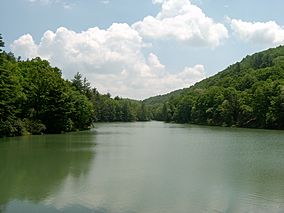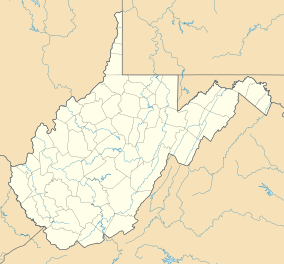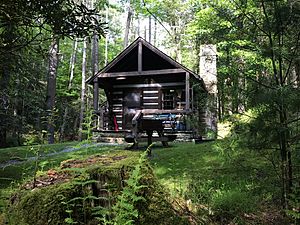Watoga State Park facts for kids
Quick facts for kids Watoga State Park |
|
|---|---|
|
IUCN Category V (Protected Landscape/Seascape)
|
|

Watoga Lake
|
|
| Location | Pocahontas, West Virginia, United States |
| Nearest town | Seebert, West Virginia |
| Area | 10,100 acres (41 km2) |
| Elevation | 2,894 ft (882 m) |
| Established | May 1934 |
| Named for | Watoga Lake |
| Governing body | West Virginia Division of Natural Resources |
| Website | |
|
New Deal Resources in Watoga State Park Historic District
|
|
| Lua error in Module:Location_map at line 420: attempt to index field 'wikibase' (a nil value). | |
| Location | HC 82 (9 miles southwest of WV 39), near Marlinton, West Virginia |
| Area | 10,269 acres (4,156 ha) |
| NRHP reference No. | 10001227 |
| Added to NRHP | February 4, 2011 |
Watoga State Park is a fantastic place to visit in West Virginia. It's located near Seebert in Pocahontas County. This park is the biggest state park in West Virginia! It covers over 10,100 acres, which is a huge area for outdoor fun.
Right next to Watoga State Park, you can find other cool spots. These include the Greenbrier River Trail, Beartown State Park, and Droop Mountain Battlefield State Park. There's also the 9,482-acre Calvin Price State Forest right next door.
Contents
Discovering Watoga's Past
The name "Watoga" comes from a Cherokee word. It means "starry waters," which sounds pretty magical! The land for Watoga was first bought in 1925. At first, it was planned to be a state forest.
How Watoga State Park Was Built
In May 1934, plans changed. They decided to make it a state park instead. A group called the Civilian Conservation Corps (CCC) did most of the building work. The CCC was a program during the Great Depression that helped young men find jobs. They built many parks and trails across the country.
Watoga State Park officially opened on July 1, 1937. Building stopped during World War II. But after the war, work started again. The first camping area opened in 1953. Then, eight fancy cabins were ready in 1956. More people started visiting in the 1960s and 1970s. This led to adding another camping area.
Today, the Watoga State Park Foundation helps the park. They work to protect its nature, history, and fun activities.
Historic Buildings and Features
Watoga State Park has many old buildings and structures. These are part of the New Deal Resources in Watoga State Park Historic District. This district is a special historic area. It includes 59 important buildings and 35 structures. You can also find 2 historic sites and 11 objects.
What You Can See at the Historic District
These historic items include water fountains and hiking trails. There's also a swimming pool and a reservoir. You can see old rental cabins and picnic shelters. Even a former CCC camp is part of this area.
The park is also home to the Fred E. Brooks Memorial Arboretum. An arboretum is like a special garden for trees and plants. This one covers 400 acres. It's named after Fred E. Brooks, a famous West Virginia naturalist. Building the arboretum started around 1935. It was officially opened in 1938. This historic district was added to the National Register of Historic Places in 2010.
Fun Things to Do at Watoga State Park
Watoga State Park offers many activities for visitors. It's a great place to enjoy nature and have an adventure.
- Stay in a Cabin: The park has 34 cozy cabins for rent.
- Go Camping: There are 2 campgrounds with 88 campsites. Fifty of these sites have electricity.
- Take a Dip: You can cool off in the park's swimming pool.
- Fishing and Boating: Enjoy the 11-acre fishing lake. You can also rent boats there.
- Explore Trails: There are 37.5 miles of hiking trails to discover.
- Visit the Arboretum: Check out the Brooks Memorial Arboretum to see different plants.
- Scenic Views: Climb up to the Ann Bailey Lookout Tower for amazing views.
- River Trail: The Greenbrier River Trail is right next to the park.
- Learn History: Visit the CCC Museum to learn about the park's past.
- Picnic Time: Enjoy a meal at one of the many picnic areas.
Exploring Watoga's Hiking Trails
Watoga State Park is famous for its many hiking trails. There are trails for everyone, no matter your skill level. You can find short, easy walks or longer, more challenging hikes.
Popular Hiking Trails
Here are some of the trails you can explore:
- Allegheny Trail
- Ann Bailey Trail
- Arrowhead Trail
- Bearpen Trail
- Brooks Memorial Arboretum Trails
- Buck and Doe Trail
- Burnside Ridge Trail
- Honeymoon Trail
- Jesse's Cove Trail
- Kennison Run Trail
- Lake Trail
- Monongaseneka Trail
- North Boundary Trail
- Pine Run Trail
- T. M. Cheek Trail
- Ten Acre Trail
- South Burnside Trail
The Watoga Foundation regularly takes care of these trails. You can find a map of all the trails by clicking here.



